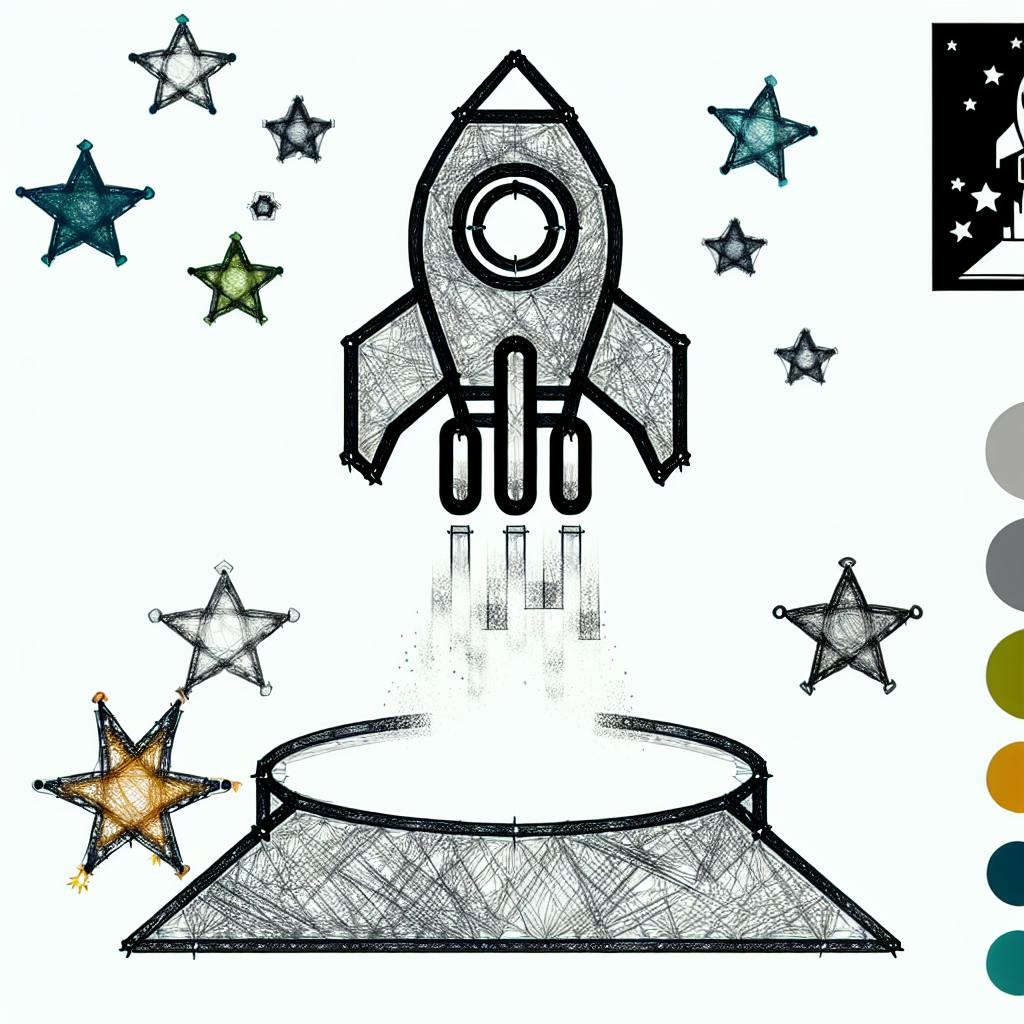User journey mapping helps startups understand their customers' experiences from start to finish, identifying pain points, improving user satisfaction, aligning with user needs, and facilitating team collaboration. Here are the 5 key steps:
-
Create User Profiles
- Gather customer data through surveys, analytics, social media, research, and interviews
- Build detailed user personas with demographics, goals, motivations, pain points, and behavior patterns
-
Map Customer Touchpoints
- Identify all channels where users interact with your brand (website, app, social media, ads, support, etc.)
- Categorize touchpoints into journey stages (awareness, consideration, purchase, post-purchase)
-
Outline User Goals and Feelings
- Align user goals with your business KPIs and objectives
- Track user emotions at each touchpoint using surveys, interviews, and biometric data
-
Map the User Journey
- Define journey stages (awareness, consideration, purchase, onboarding, usage, advocacy)
- Identify pain points and improve touchpoints for a seamless experience
-
Find Key Moments and Areas to Improve
- Identify critical interactions that shape user decisions and experiences
- Prioritize UX changes based on user feedback, behavior, business goals, and resources
By following these steps, startups can create a user journey map that drives user satisfaction, loyalty, and business success.
| Key Benefits of User Journey Mapping |
|---|
| Identify pain points |
| Improve user satisfaction |
| Align with user needs |
| Facilitate team collaboration |
Related video from YouTube
1. Create User Profiles
Creating user profiles is the first step in mapping your startup's user journey. A user profile, also known as a buyer persona, is a semi-fictional representation of your ideal customer based on real data and research. It helps you understand your customers' needs, goals, behaviors, and pain points, enabling you to tailor your product or service to meet their expectations.
Gather Customer Data
To create a user profile, you need to gather data about your customers. You can collect this data through:
- Customer surveys and feedback forms
- Analytics tools, such as Google Analytics
- Social media listening and monitoring
- Market research and competitor analysis
- Customer interviews and focus groups
The data you collect should include:
| Data Type | Description |
|---|---|
| Demographic | Age, location, job title, income level |
| Behavioral | Purchase history, browsing habits |
Build User Personas
Once you have gathered sufficient data, you can start building your user personas. A user persona should include:
| Persona Element | Description |
|---|---|
| Name and job title | Give your persona a name and job title |
| Demographic information | Age, location, income level |
| Goals and motivations | What they want to achieve and what drives their behavior |
| Pain points and challenges | What frustrates them or what they struggle with |
| Behavior patterns | How they interact with your product or service |
By creating detailed user personas, you can gain a deeper understanding of your customers' needs and preferences, enabling you to design a user journey that meets their expectations.
Remember, user profiles are not static and should be regularly updated based on new data and insights. This will ensure that your product or service remains relevant and appealing to your target audience.
2. Map Customer Touchpoints
Identify User Interactions
To understand your customers' journey, you need to know where and how they interact with your startup. Use analytics tools like Google Analytics to track user behavior on your website or app. Look at metrics like page views, click-through rates, and conversion rates to find the most popular pages and features. Also, analyze user flows to see how customers navigate through your site and identify potential drop-off points.
List All Touchpoints
Customers can interact with your startup through various channels, both online and offline. Create a list of all the touchpoints where your customers might engage with your brand. These can include:
- Website
- Mobile app
- Social media platforms
- Email campaigns
- Advertising (online, print, TV, etc.)
- Events and conferences
- Customer support channels (phone, chat, email)
- Physical stores or pop-up shops (if applicable)
- Word-of-mouth referrals
Categorize these touchpoints into different stages of the customer journey, such as awareness, consideration, purchase, and post-purchase. This will help you understand the role each touchpoint plays in the overall customer experience.
| Touchpoint | Stage |
|---|---|
| Social media ads | Awareness |
| Product demos | Consideration |
| Online store | Purchase |
| Customer support | Post-purchase |
By mapping all customer touchpoints and analyzing user interactions, you can identify areas for improvement and optimize the customer journey for a seamless experience.
3. Outline User Goals and Feelings
Align Goals with Business
To create a product or service that meets both user needs and business goals, you need to align user goals with your startup's objectives. Here's how:
- Identify key performance indicators (KPIs): Determine the metrics that measure the success of your startup.
- Conduct user research: Gather data on your target audience, including their needs, pain points, and goals.
- Analyze user feedback: Collect feedback from users through surveys, reviews, or support requests.
By aligning user goals with business objectives, you can create a product or service that drives success for your startup.
Track User Emotions
Tracking user emotions helps you understand the emotional journey users experience when interacting with your startup. This understanding allows you to identify points of delight or frustration, making it possible to optimize the user experience. Here are some techniques to track user emotions:
| Technique | Description |
|---|---|
| Surveys and questionnaires | Ask users to rate their emotions or feelings using scales, emojis, or words. |
| Interviews and focus groups | Conduct in-depth interviews or focus groups to explore users' emotions and feelings in more depth. |
| Biometric data analysis | Collect data from users' actions, reactions, and responses to measure their emotions and feelings objectively. |
By tracking user emotions, you can identify areas for improvement and optimize the user experience to create a more engaging and satisfying interaction with your startup.
sbb-itb-74f63ba
4. Map the User Journey
Now that you have outlined your user goals and feelings, it's time to map the user journey. This step involves plotting the user's path through different stages of engagement with your product or service.
Define Journey Stages
Identify the main phases a user experiences with your startup. These stages can include:
| Stage | Description |
|---|---|
| Awareness | The user becomes aware of your product or service. |
| Consideration | The user evaluates your product or service against others. |
| Purchase | The user decides to buy your product or service. |
| Onboarding | The user sets up and starts using your product or service. |
| Usage | The user continues to use your product or service. |
| Advocacy | The user becomes a loyal customer and advocates for your product or service. |
Improve Touchpoints
Once you have defined the journey stages, it's essential to improve each touchpoint to optimize the overall user journey. A touchpoint is any interaction a user has with your product or service, such as visiting your website, using your app, or contacting customer support.
To improve touchpoints, consider the following:
- Identify pain points: Analyze user feedback and data to identify areas where users are struggling or experiencing frustration.
- Simplify interactions: Make it easy for users to complete tasks and achieve their goals.
- Provide clear communication: Ensure that users receive clear and concise information about your product or service.
- Offer support: Provide multiple channels for users to get help and support when needed.
By improving touchpoints, you can create a seamless and enjoyable user experience that drives engagement and loyalty.
5. Find Key Moments and Areas to Improve
To drive improvements, identify critical moments in the user experience. Analyze user feedback, data, and behavior to understand where users struggle or experience friction.
Identify Critical Interactions
Critical interactions shape user decisions and experiences. These can be positive, like a seamless onboarding process, or negative, like a frustrating error message.
| Interaction | Description |
|---|---|
| First-time user experience | The user's initial experience with your product or service. |
| Error messages | The user encounters an error or issue while using your product or service. |
| Payment processing | The user completes a purchase or transaction. |
| Customer support | The user interacts with your customer support team. |
Prioritize Changes
Prioritize UX changes based on their impact and user needs. Consider the following factors:
- User feedback: Analyze user feedback to understand what's working and what's not.
- User behavior: Study user behavior to identify patterns and areas of friction.
- Business goals: Align UX changes with business goals and objectives.
- Resource allocation: Prioritize changes based on resource availability and feasibility.
By prioritizing UX changes, you can create a roadmap for improvement that drives user satisfaction, loyalty, and ultimately, business success.
Summary of User Journey Mapping
A user journey map is a valuable tool for startups to understand their customers' needs, behaviors, and pain points. By mapping the user journey, startups can identify areas of friction, opportunities for improvement, and moments of delight.
The 5-Step Process
To create a user journey map, follow these five key steps:
1. Create user profiles: Gather customer data and build user personas to understand their goals, behaviors, and motivations.
2. Map customer touchpoints: Analyze user interactions and identify all the touchpoints where customers interact with your brand.
3. Outline user goals and feelings: Align user goals with business objectives and track user emotions throughout the journey.
4. Map the user journey: Define journey stages, identify pain points, and improve touchpoints to create a seamless user experience.
5. Find key moments and areas to improve: Identify critical interactions, prioritize UX changes, and allocate resources to drive business growth.
By following these steps, startups can create a user journey map that drives user satisfaction, loyalty, and ultimately, business success.
FAQs
How do you create a user journey diagram?
To create a user journey diagram, follow these steps:
1. Create user personas: Gather data on your target users, including their demographics, behaviors, goals, and pain points. Use this information to create detailed user personas.
2. Map user touchpoints: Identify all the touchpoints where users interact with your product or service.
3. Outline user goals and emotions: Define the goals that users aim to achieve at each stage of their journey. Track the emotions they experience, both positive and negative.
4. Visualize the journey stages: Divide the user journey into distinct stages, such as awareness, consideration, purchase, onboarding, and retention. Map out the user's actions, thoughts, and emotions at each stage.
5. Identify pain points and opportunities: Analyze the user journey map to pinpoint areas of friction, frustration, or confusion for users.
How to analyze user journey?
To analyze the user journey, follow these steps:
1. Identify touchpoints and interactions: List all the channels and touchpoints where users interact with your product or service.
2. Measure user interactions: Use analytics tools to track user behavior and interactions on each channel.
3. Set up an attribution program: Implement an attribution model to understand the customer journey across multiple touchpoints.
4. Identify where and why customers churn: Analyze user behavior and feedback to pinpoint the stages or touchpoints where customers tend to disengage or churn.
5. Create a customer journey map: Consolidate your findings into a visual customer journey map that outlines the stages, touchpoints, user actions, emotions, and pain points.
By following these steps, you can create a user journey map that helps you understand your customers' needs, behaviors, and pain points, ultimately driving user satisfaction, loyalty, and business success.

